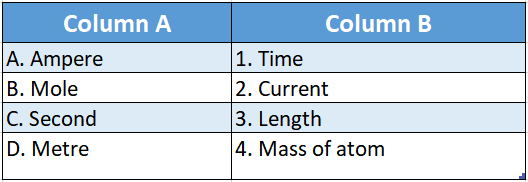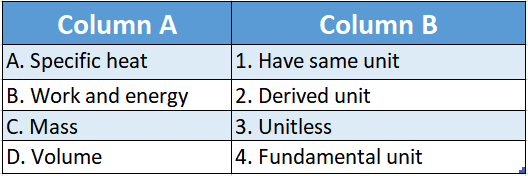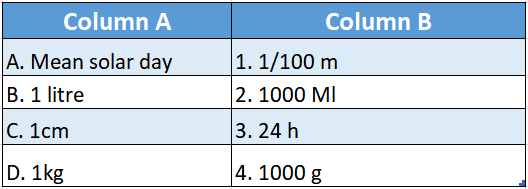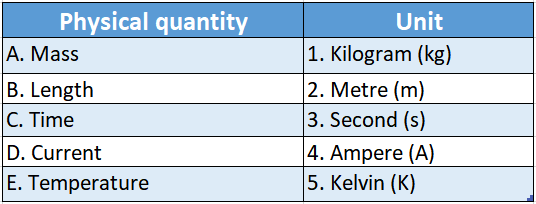Chapter 5 Measurement Review Questions Environment Review Questions MCQs
Question 1. The SL system has a number of elementary fundamental units.
- 6
- 7
- 8
- 9
Answer: 2. 7
Question 2. An example of a fundamental quantity is
- Volume
- Velocity
- Height
- Area
Answer: 3. Height
Read And Learn More: WBBSE Solutions For Class 6 School Science
Question 3. The SI unit of volume is
- cm/s
- m/s2
- cc
- cubic metre
Answer: 4. cubic metre
Question 4. Which of the following physical quantities does not have a unit?
- Mass
- Specific gravity
- Volume
- Current
Answer: 2. Specific gravity
Question 5. Which among the following is not a fundamental quantity?
- Temperature
- Mass
- Intensity of light
- Density
Answer: 4. Density
WBBSE Class 6 Science Question Answer
Question 6. The quantity of atoms or molecules has the unit of
- kg
- cc
- mole
- g
Answer: 3. mole
Question 7. The biggest unit of length is
- Parsec
- Angstrom
- Kilometre
- Micron
Answer: 1. Parsec
Question 8. A light year is a unit of
- Time
- Intensity of light
- Temperature
- Density
Answer: 4. Density
Question 9. Common balance measures
- Weight
- Mass
- Density
- Volume
Answer: 2. Mass
Question 10. The most accurate model of the timekeeper is
- Stop-watch
- Atomic clock
- Wrist-watch
- Digital clock
Answer: 2. Atomic clock
Question 11. The common instrument employed to measure the growth of plants is
- Stop-watch
- Centimetre scale.
- Measuring cylinder
- Auxanometer
Answer: 4. Auxanometer
Question 12. A measuring cylinder can be used to measure the volume of
- Liquid only
- Solid only
- Both liquid and solid
- None of the above
Answer: 3. Both liquid and solid
Question 13. 1 mean solar day =.minutes.
- 1440
- 24
- 60
- 86400
Answer: 1. 1440
Question 14. The smallest division of a metre scale is
- 1 m
- 1 cm
- 1 dm
- 1mm
Answer: 4. 1mm
WBBSE Class 6 Science Question Answer
Question 15. Time is defined as
- Starting an event
- Ending of an event
- The interval between two events
- None of the above
Answer: 3. Interval between two events
Question 16. The volume of 1 L of water is
- Less than 1 cubic decimetre
- Greater than 1 cubic decimetre
- Equal to 1 cubic decimetre
- Equal to 100 cubic centimetres
Answer: 3. Equal to 1 cubic decimetre
Question 17. Which is not a unit of area?
- Square cm
- Square metre
- M/S
- Square km
Answer: 3. M/S
Question 18. Your body weight is 30 kg, i.e.ing.
- 300
- 3000
- 30,000
- 3
Answer: 3. 30,000
Question 19. Hour is a
- fundamental unit
- derived unit
- number
- none of the above events of short duration
Answer: 2. derived unit
WBBSE Class 6 Science Question Answer
Question 20. Time pertaining to an
- Wrist-watch
- Sundial
- Wall clock
- Stop-watch
Answer: 4. stop-watch
Question 21. Angstrom is the unit of
- Mass
- Length
- tTme
- Current
Answer: 2. length
Question 22. The rate of growth is
- Growth/time
- Time/growth
- Growth x time
- Time
Answer: 1. Growth/time
Question 23. A standard unit should be
- Of convenient size to use
- Fixed under any conditions of space and time
- Defined without doubt
- All of the above
Answer: 4. All of the above
Question 24. The area of the rectangular surface is
- Length x Breadth
- Length + Breadth
- Length/Breadth
- 2 x (Length + Breadth)
Answer: 1. Length x Breadth
Question 25. In MKS system, K stands for
- Kelvin
- Kilometre
- Kilogram
- None of the above
Answer: 2. Kilometre
WBBSE Class 6 Science Question Answer
Question 26. A glass is filled to the brim with water. When you immerse one of your fingers into it, some amount of water is spilt out. Which parameter among the following is the same for the water that is spilt out and the immersed portion of the finger?
- mass
- length
- weight
- volume
Answer: 3. volume
Question 27. Using a digital stop-watch, we can measure time upto
- 0.1s
- 0.01s
- 0.2s
- 0.02s
Answer: 2. 0.01s
Question 28. To express your weight, which unit among the following should you use?
- quintal
- mg
- kg
- g
Answer: 3. kg
Question 29. An incorrect estimate is
- overestimate
- underestimate
- both
- none
Answer: 3. both
Class 6 WBBSE Science Question Answer
Question 30. Among the following, the pair having the same unit is
- energy and work
- volume and density
- force and energy
- work and power
Answer: 1. energy and work
Chapter 5 Measurement Fill In The Blanks
Question 1. The space occupied by any substance is called ___________
Answer: Volume
Question 2. Mass/Volume= ___________
Answer: Density
Question 3. 1 litre = ___________ CC.
Answer: 1000
Question 4. SI unit of time is ___________
Answer: Second
Question 5. To measure the length of your classroom you may use ___________
Answer: Measuring tape
Question 6. Everything which can be measured is called a ___________
Answer: Physical quantity
Question 7. Sl unit of temperature is ___________
Answer: Kelvin
Question 8. A scale having a length of one metre is called a ___________ scale.
Answer: Metre
Question 9. Cubic centimetre is the unit of ___________
Answer: Volume
Question 10. An estimate that exceeds the actual is called an ___________
Answer: Overestimate
Class 6 WBBSE Science Question Answer
Question 11. Growth is attended by ___________ in weight.
Answer: Increase
Question 12. 1 second = ___________ part of an hour.
Answer: 1/3600
Question 13. The volume of liquid is usually expressed in ___________
Answer: Litre
Question 14. Temperature is a ___________ physical quantity.
Answer: Fundamental
Question 15. 10 dm is equal to ___________ metre.
Answer: 1
Question 16. The unit of mass in the FPS system is ___________
Answer: Pound
Question 17. Velocity is a ____________unit.
Answer: Derived
Question 18. ___________units are a combination of one or more fundamental units.
Answer: Derived
Question 19. The height of a person is measured with ___________
Answer: Centimetra scale
Question 20. An informal estimate when very little information is available is called a ___________
Answer: Guesstimate
Question 21. If the area is sq. cm, then ___________ → century.
Answer: Time
Question 22. If length scale, the volume of liquid → ___________.
Answer: Measuring cylinder
Question 23. To measure the purity of gold, ___________ is used.
Answer: Carat
Question 24. The interval between the start of an event and its completion is called ___________
Answer: Time
Question 25. There are ___________ elementary or fundamental units in Sl system of measurement.
Answer: Seven
Class 6 WBBSE Science Question Answer
Chapter 5 Measurement Identify As True Or False
Question 1. A light year is a fundamental unit
Answer: True
Question 2. Precise measurement is not very important in our daily lives.
Answer: False
Question 3. The surface area of a sphere = × diameter x diameter.
Answer: True
Question 4. We can use a stopwatch instead of a wristwatch to see the time.
Answer: False
Question 5. Length, mass and time are derived units.
Answer: False
Question 6. Growth in animals takes place throughout life.
Answer: False
Question 7. Estimation is an approximation.
Answer: True
Class 6 WBBSE Science Question Answer
Question 8. A common balance gives a direct measurement of mass.
Answer: False
Question 9. Millimetre is a sub-multiple of Metre.
Answer: True
Question 10. All the physical quantities have separate units.
Answer: False
Question 11. The fundamental unit of current is Ampere in the SI system.
Answer: True
Question 12. Derived physical units are more number than fundamental units.
Answer: True
Question 13. Bamboo shoots grow rapidly.
Answer: True
Question 14. The area is a fundamental quantity.
Answer: False
Question 15. 1 Mean solar day = 86400 seconds.
Answer: True
Question 16. Direct measurement of the volume of liquid can be done by using a measuring cylinder.
Answer: True
Question 17. All the systems of units have a common unit of time.
Answer: True
Question 18. In the MKS system, M stands for milligram.
Answer: False
Question 19. There are 7 derived physical quantities in the SI system.
Answer: False
Question 20. One litre of milk is equivalent to 1000 cc of milk.
Answer: True
Question 21. Velocity = Distance/Time.
Answer: True
Class 6 Science Question Answer WBBSE
Question 22. Atomic weight has no unit.
Answer: True
Question 23. A cubit is a standard unit.
Answer: False
Question 24. Growth is accompanied by a reversible change of structure or form.
Answer: False
Question 25. A scale may have different lengths.
Answer: True
Chapter 5 Measurement Match The Columns

Answer: A-2,B-4,C-1,D-3

Answer: A-4,B-3,C-1,D-2

Answer:

Answer:
Chapter 5 Measurement Answer In Words Or A Sentence
Question 1. Mention two physical quantities which have the same unit.
Answer: Work and energy.
Question 2. What is the unit associated with the measurement of the mass of a molecule?
Answer: Mole.
Question 3. What is the relation between hectometre and metre?
Answer: 1 hm = 100 m.
Question 4. Which unit is used to measure sub-atomic distances?
Answer: Fermi is used.
Class 6 Science Question Answer WBBSE
Question 5. How does a mason give us measurements of things he needs before starting any construction work?
Answer: By estimation.
Question 6. What is the instrument employed to measure the growth of animals?
Answer: The centimetre scale is used to measure the growth of animals.
Question 7. How many seconds are there in a mean solar day?
Answer: 1 mean solar day = 86400 seconds.
Question 8. Which unit would you prefer to use to measure the distance between two cities-kilometre or metres?
Answer: Kilometre.
Question 9. How many fundamental physical quantities are there as per the Sl system?
Answer: Seven fundamental physical quantities are there as per the Sl system.
Question 10. What type of quantity is the intensity of light?
Answer: Fundamental physical quantity.
Question 11. I am a derived unit. In order to compute my value, mass is to be divided by volume. Who am I?
Answer: Density(\(=\frac{Mass}{Volume}\))
Question 12. Find the odd one out Length, time, volume, mass.
Answer: Volume: It is a derived quantity while others are fundamental quantities.
Question 13. Give an example where one has to necessarily take the help of estimation to do work.
Answer: Getting hold of a cricket ball by a fielder when he jumps near the boundary line.
Question 14. What type of measuring device would you use to measure the girth of a tree?
Answer: A measuring tape.
Question 15. What is the biggest unit of time?
Answer: Century = 100 years.
Chapter 5 Measurement Qshort Answer Type Questions
Question 1. A body measures 25 m. State the unit and the magnitude of the unit in the statement.
Answer: The statement of a physical quantity (length) shows that the unit is the metre and the magnitude is 25.
Question 2. Define fundamental unit. Name the fundamental units of mass, length, time, current and temperature.
Answer: There are some physical quantities which do not depend on other physical quantities, e.g. length, mass, time, etc.
Class 6 Science Question Answer WBBSE
These physical quantities are called fundamental physical quantities and the units associated with them are called fundamental units. These are independent of any other units.

Question 3. Why is the unit of volume a derived unit?
Answer: Volume = length x breadth x height.
The fundamental unit of length appears thrice in the formula of volume i.e. volume is the cube of length. Hence it is a derived unit.
Question 4. Name the convenient unit you would use to measure-
Answer:
- length of a hall
- width of a book
- diameter of a hair
- distance between two cities

Question 5. Define time. Express minute as a part of a mean solar day.
Answer: The interval between any two incidents is called time.
1 minute = 1/1440 mean solar day.
Question 6. What do we measure with the help of a thermometer?
Answer: We measure the temperature of a substance with the help of a thermometer.
Question 7. What is a metre scale?
Answer: If the length of the scale is one metre it is called a metre scale.
Question 8. What do the longer and shorter arms of a stopwatch measure?
Answer: The longer hand of a stopwatch records time in seconds with fractions and the shorter one in minutes.
Class 6 Science Question Answer WBBSE
Question 9. State the units in which mass is measured in (i) the CGS system and (ii) the Sl system.
Name the most convenient unit of mass you will use to measure-
Answer:
- Mass of a small amount of medicine.
- The bag of sugar.
- Mass of a cricket ball.
- The CGS unit of mass is gram (g) and that in the SI system is the kilogram (kg).

Question 10. Do ratios have units?
Answer: Ratios do not have units. They are unitless physical quantities.
Question 11. Give one example for each of the derived physical quantities having one or two fundamental physical quantities.
Answer: Area (length x breadth) has one fundamental physical quantity.
Velocity (distance/time) has two fundamental physical quantities.
Question 12. Can the volume of a lump of sugar candy be measured with water in a measuring cylinder?
Answer: The lump of sugar would gradually dissolve in water when it is dipped inside water in a measuring cylinder. Hence its volume can not be measured with water.
Question 13. You are given a flexible wire of 10 cm in length. How would you measure a length of 1 m 5 cm with that?
Answer: 1 m is a multiple of 10 cm, since 1 m= 100 cm. Hence, 10 times the full length of the wire measures 1 m.
Since the length of the wire is 10 cm, if it is folded to half, the length of folded wire equals 5 cm. So the measurement involves 10 full lengths of the wire and one-half length of the wire.
Question 14. A bottle of juice holds 750 ml of juice. Can two such bottles be poured into a jar measuring 2000 cc?
Answer: One bottle holds 750 ml.
.: Two bottles hold (750×2) ml =1500 ml = 1500 cc
Since the capacity of the jar is 2000 cc, hence the two bottles can be poured into it.
Question 15. A 30cm scale has one end broken. The mark at
the broken end is 2.6 cm. While measuring the length of a pencil, one end is touched with a 2.6 cm mark and the other end touches the 18.1 cm mark. What is the length of the pencil?
Answer: Length of pencil = (18.1-2.6) cm= 15.5 cm = 155 mm
Question 16. What are the components of the bar on which ‘metre’ is depicted?
Answer: The bar is made of an alloy consisting of 90 per cent platinum and 10 per cent iridium.
Chapter 5 Measurement Long Answer Type Questions
Question 1. Define measurement. What is the unit? Do all physical quantities have units?
Answer: The average of the varying solar days over a period of 365 days is called the mean solar day.
Question 2. How would you measure the length of a curved line with a thread and an ordinary ruler?
Answer: A piece of thread is taken. A required portion of the thread is very carefully laid over the given curved line such that the thread completely hides the whole stretch of the line.
Now the length of the straightened part of the thread that was used just to cover up the given line is measured with the help of the ruler which gives the length of the given curved line.
Question 3. How will you measure the rate of plant growth?
Answer: A required portion of the thread is very carefully laid over the given curved line such that the thread completely hides the whole stretch of the line.
Question 4. What is Mean Solar Day? How would you derive the concept of second from it?
Answer: The average of the varying solar days over a period of 365 days is called the mean solar day. When the average or mean solar day is divided by 24, we get 1 hour.
Similarly, dividing 1 hour by 60 we get 1 minute and further dividing this 1 minute by 60, we get 1 second.
Thus,
1 Mean solar day = 24 hours = 24 x 60 minutes = 1440 minutes = 1440 x 60 seconds
= 86400 seconds.
This second is the SI unit of time equal to
1/86,400 of a mean solar day.
Question 5. Explain how a stopwatch work.
Answer: A stopwatch is used to note the time of an event of short duration. It can record 1/5th or even 1/ 10th of a second.
The longer hand records time in seconds with fractions and the shorter one in minutes. There is a press button which, when pressed, starts the watch and if pressed for the second time, stops the watch.
If again the button is pressed, the second and the minute hands return to their own zero mark.
Thus this watch can be started or stopped by pressing its press button just at the beginning and at the end of an event like a race in sports.
Question 6. How would you measure the mass of a substance?
Answer: The mass of a substance is measured indirectly with the help of common balance.
The substance of unknown mass is to be kept on the left scale pan of the common balance and standard known masses in the right scale pan.
When the pointer comes to equilibrium, the mass of the substance is measured as equal to the known standard masses.
Question 7. How can you find the thickness of a single strand of hair?
Answer: Take a single strand of hair and twist it around a pencil very closely together say 30 times. Measure the length of the total number of twists with a scale.
If the length is x cm, then the thickness of a single strand shall be =x/30 cm.
Question 8. You have got a common balance, a kg weight and a sack of rice. How can you measure the mass of 250 g of rice with the help of the common balance and the one kg weight?
Answer: First we measure 1 kg of rice with the help of one kg weight.
Then one kg weight is removed from the right scale pan and the 1 kg rice from the left scale pan is distributed equally among the right and left scale pans till the pointer comes to equilibrium.
At this point, we have 500 g of rice on both scale pans.
Next rice from one scale pan is to be removed and the above process is to be repeated once again to get 250 g of rice in each of the scale pans.
Question 9. If two boys measure the length of the classroom with their hands, will they get the same result? The water level in a measuring cylinder shows a reading of 12.4 ml. A marble is placed inside it and the reading shows 20.2 ml. What is the volume of the marble?
Answer: Handspan or cubit cannot be used as a standard unit of length. The cubit could vary considerably due to the different sizes of handspan of people.
This results in inaccurate values which is the biggest limitation. Thus the two boys would get different results depending on their handspans.
They should use a measuring tape to correctly measure the length of their classroom.
When completely immersed in water, the marble shall dispense a volume of water which is equal to its own volume. 1st reading = 12.4 ml 2nd reading = 20.2 ml
.: Volume of marble=(20.2-12.4) ml 7.8 ml
Question 10. Mention two significances of estimation. Mention three examples from our daily life where we are forced to adopt estimation. Significances of estimation.
Answer: 1. Estimation helps to obtain approximate knowledge about quantities when other resources are not available.
2. it helps to plan ahead and obtain approximate knowledge about the quantities which are otherwise very difficult to measure precisely.
Instances in our daily life where we estimate:
1. While measuring and adding spices, oil etc into food matters during cooking
2. While touching somebody’s forehead to

